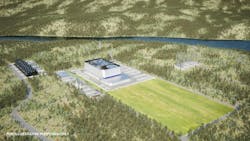TVA Seeks NRC Construction Permit to Build SMR Nuclear in Tennessee
Tennessee Valley Authority has asked the U.S. Nuclear Regulatory Commission to consider its request to build a small modular reactor (SMR) nuclear power plant in its home state.
The SMR construction permit application to the NRC is the first by a U.S. utility. Federal utility agency TVA plans to install the GE Vernova Hitachi Nuclear Energy’s BWRX-300 reactor technology at its Clinch River site near Oak Ridge, Tennessee.
Other SMR startups such as X-energy and NuScale Power have submitted permit applications to the NRC. No small nuclear reactor project has been built or even started construction in the U.S. so far.
"This is a significant milestone for TVA, our region and our nation because we are accelerating the development of new nuclear technology, its supply chain and delivery model to unleash American energy,” Don Moul, TVA president and CEO, said in a statement. “TVA has put in the work to advance the design and develop the first application for the BWRX-300 technology, creating a path for other utilities who choose to build the same technology. TVA looks forward to working with the (Trump) Administration to accelerate advanced nuclear technologies that are key to our nation's energy security. We believe deploying new nuclear is essential to providing American families and businesses affordable and abundant electricity for decades to come."
Nuclear reactor-generated power is carbon-free and baseload electricity which can provide high-capacity factor generation. The nation’s conventional nuclear reactors currently account for about 18% of total U.S. utility-scale electricity and more than half of its carbon-free power generated.
SMRs are envisioned as the next generation of nuclear technology, with passive safety features, smaller footprints and more scalable, less expensive designs. Opponents say that even SMRs are still too expensive, potentially hazardous and create radioactive waste.
But the nation is in an electric power quandary with artificial intelligence training and cloud-based data center capacity rising exponentially and stressing future utility-scale delivery. Some forecasters, such as Goldman Sachs, are predicting at least a doubling of data center capacity and perhaps another 50 GW needed.
Tech giants such as Microsoft, Oracle, Amazon Web Services and Google all are pursuing or have signed power agreements with SMR and conventional nuclear producers.
TVA gained an early site permit for the Clinch River SMR plan several years ago. The plan is to install two or more BWRX-300 reactors, each of which are being designed to generate about 300 MW of around-the-clock, carbon-free power.
Industrial firm Dow recently submitted its construction permit application to the NRC for an X-energy SMR site planned to power operations at Dow’s Seadrift manufacturing facility on the Texas Gulf Coast. The NRC agreed to review the construction permit application by Long Mott Generating, the Dow company which is operating the currently gas-fired industrial power plant. The Long Mott gas plant is due to be retired soon.
GE Vernova Hitachi Nuclear Energy and TVA entered into their SMR agreement in 2022 to build the SMR at Clinch River. Canadian utility Ontario Power Generation also has accepted the BWRX-300 as part of its SMR plans.
SMR nuclear will not be cheap to build, with some estimates at $7 billion for the first commissioned reactor. Proponents say the cost will come down and no other resource offers baseload and carbon-free energy required to power data centers, industrial and other mission-critical operations.
Nuclear energy reactors are built for longer lifetimes than most electricity generation technology. Numerous utilities have successfully licensed some plants to run as long as 89 years.
The TVA is among numerous entities seeking an $800 million U.S. Department of Energy grant to accelerate BWRX-300 deployment. Most industry leaders predict the first SMRs will be built in the U.S.. by the early to mid 2030s.
Small, Modular and Reactive Future
Read EnergyTech's Full Coverage of SMRs
About the Author
Rod Walton, EnergyTech Managing Editor
Managing Editor
For EnergyTech editorial inquiries, please contact Managing Editor Rod Walton at [email protected].
Rod Walton has spent 17 years covering the energy industry as a newspaper and trade journalist. He formerly was energy writer and business editor at the Tulsa World. Later, he spent six years covering the electricity power sector for Pennwell and Clarion Events. He joined Endeavor and EnergyTech in November 2021.
Walton earned his Bachelors degree in journalism from the University of Oklahoma. His career stops include the Moore American, Bartlesville Examiner-Enterprise, Wagoner Tribune and Tulsa World.
EnergyTech is focused on the mission critical and large-scale energy users and their sustainability and resiliency goals. These include the commercial and industrial sectors, as well as the military, universities, data centers and microgrids. The C&I sectors together account for close to 30 percent of greenhouse gas emissions in the U.S.
He was named Managing Editor for Microgrid Knowledge and EnergyTech starting July 1, 2023
Many large-scale energy users such as Fortune 500 companies, and mission-critical users such as military bases, universities, healthcare facilities, public safety and data centers, shifting their energy priorities to reach net-zero carbon goals within the coming decades. These include plans for renewable energy power purchase agreements, but also on-site resiliency projects such as microgrids, combined heat and power, rooftop solar, energy storage, digitalization and building efficiency upgrades.

